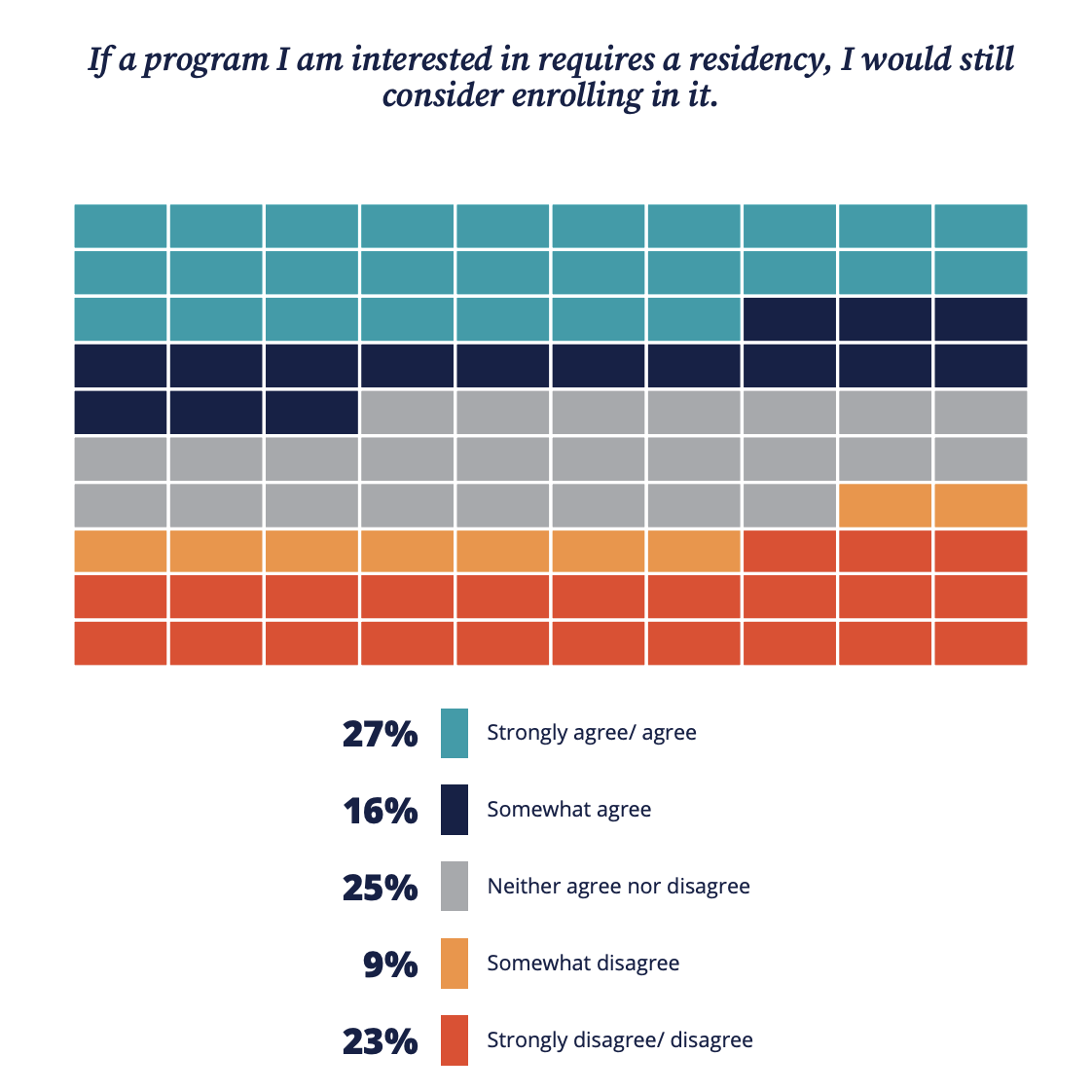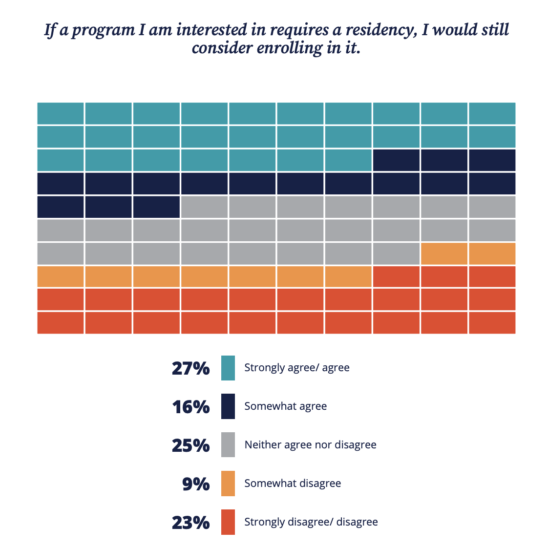
Magda, A. J., Capranos, D., & Aslanian, C. B., (2020) Online college students 2020: Comprehensive data on demands and preferences Louisville, KY: Wiley Education Services.
Aslanian, C.B., Fischer, S.(2021), Online College Students 2021 Meeting Online Student Demands and Preferences in a Reshaped World Hoboken. NJ: EducationDynamics
The first study was conducted in January/February 2020, before Covid-19 impacted on the higher education system in the USA. The second was conducted in April/May 2021, when Covid-19 was in full swing.
However, these two studies have a lot in common. Both studies surveyed students who were already online students in the previous 12 months. As can be seen, Carol Aslanian was a co-author of both studies. They are a continuation of similar studies going back to 2011.
The 2020 study (pre-Covid)
Methodology
In the winter of 2020, Wiley Education Services and Aslanian Market Research conducted surveys of 1,618 individuals nationwide. Respondents were at least 18 years of age, had a minimum of a high school degree or equivalent, and were recently enrolled, currently enrolled, or planned to enroll in the next twelve months in a fully online undergraduate or graduate degree, certificate, or licensure program. Respondents hailed from all 50 states.
Graduate students represent 15.2% of the total college population but 28.6% of the online population. The sample for this survey was weighted to be made up of approximately 40% graduate students to ensure a large enough sample for meaningful conclusions.
Note that these are then students taking a fully online program, not students opting for online courses in otherwise on-campus programs. However, it is a very carefully drawn sample and is likely to be representative of all students taking fully online programs in the USA. It is not possible to say whether the results would apply equally to Canadian students taking fully online programs, although many of the results match my experience of Canadian online students.
Main results
The following factors influenced which institution a student would choose for their online program:
- Familiarity. 75% of respondents chose a school within 50 miles of their home address; 50% chose a school within 15 miles..
- Reputation. 64% of students are willing to pay more in tuition if they feel they are gaining something from it. 39% of respondents would consider that gain to be the reputation of the school.
- Cost is an important factor in choice of an online program (for 51% of respondents), but it is not the only factor as can be seen from the other results.
- The quickest path to program completion. Online college students are interested in speed during all aspects of their program, from the point of starting their search to submitting their first application. An important factor for online college students is the ability to apply transfer credits toward their degree program.
- Available programs. More than half of online college students note that if their online program were not available at their chosen school, they would look for a similar online program elsewhere. Notably, they would not consider enrolling in an on-campus program or pursue another field of study at their chosen college or university.
- MOOCs remain on the periphery. The number of current or prospective students who have enrolled in a MOOC previously remains low at just 13%. 57% of those who have taken a MOOC are unsure if they are a proper route to their goals or if their employers value them.
- Many open to a little blended learning. 43% of online college students are open to a program requiring a residency or attendance on campus, However, a third (32%) probably would not consider a program if it included a residency, such as required time on campus or an off-campus site.

The survey also asked about career services (most online students wanted career advice from their institution) and alumni/continuing connections after completion of programs. As always, for more details read the full report.
The 2021 study (during the pandemic)
In the Spring of 2021, EducationDynamics surveyed a sample of 675 online students who studied online within the past 12 months (500 undergraduate and 175 graduate students). These were students who either studied online of their own volition or had their program converted to an online program in the wake of the COVID-19 pandemic. Those students who had a program converted to an online program from a classroom program and did not view themselves as a “voluntary online student” also had to indicate that they would continue to study online in the future (rating of 3 on a 5-point scale of likelihood). Thus the sample did NOT include students who were not interested in continuing to study online,. Thus the type of student sampled is similar in both of these studies.
Main results
- Most students in the sample (78%) had some prior experience of online learning (mostly individual online courses – 54%), but 22% had no prior experience but indicated they would continue with online learning (a necessary condition for being included in the sample).
- 61% of the sample had no choice: the college required them to study online during Covid-19. However, 38% wanted to study online anyway.
- About two-thirds used mobile devices for study purposes, mostly (70%)for scheduling reasons (checking assignment deadlines, etc.), but also for communicating with instructors (50%); 24% did not want to use mobile devices for online study. Between a third and a half used mobile devices for other course-related activities, such as additional research or participating in online discussion forums.
- Most students in the sample (75%) rated their online courses as good as or better than their classroom-based study.
- Most students in the sample (74%), particularly graduates (84%), agreed that their online education was worth the cost
- Post-Covid 19, a slight majority (57%) said they would like to enrol in hybrid courses, 34% still wanted to study primarily online, and only 9% (mainly undergraduates) wanted to go back to classroom teaching.
- The vast majority of respondents who prefer classroom or hybrid study (91%) would be interested in a study option that recorded classroom lectures for students to watch at their convenience if they missed a live classroom session.
- Nearly all students in the sample (93%) liked the idea of stackable certificates
-
Two-thirds of respondents indicated they would not consider changing schools if their program is offered online in the Fall 2021 semester.
The report also has substantial sections on student responses to career guidance, enrolment strategies, student financing and technology access (most students in this sample had good internet access, a quiet room, and a dedicated computer for study). For more details, please see the actual report.
Comments
Both of these studies are based on a highly selective sample of students who have opted for online learning as a preferred study method. I was hoping that the 2021 study would have highlighted differences that resulted from the switch to emergency remote learning. A comparison with students who had NOT previously opted for online courses would have been of particular value, but this was a lost opportunity. Also, these studies do not throw much light on the much larger group of students who mix online courses with face-to-face courses.
Nevertheless the studies provide useful insights into the nature of ‘dedicated’ online learners, particularly those who are fully online students, at least in the USA. Fully online students will be an increasingly important market and it is important to understand their needs and interests. These two reports contain a lot of useful information for those concerned with the enrolment and retainment of such students.









 Dr. Tony Bates is the author of eleven books in the field of online learning and distance education. He has provided consulting services specializing in training in the planning and management of online learning and distance education, working with over 40 organizations in 25 countries. Tony is a Research Associate with Contact North | Contact Nord, Ontario’s Distance Education & Training Network.
Dr. Tony Bates is the author of eleven books in the field of online learning and distance education. He has provided consulting services specializing in training in the planning and management of online learning and distance education, working with over 40 organizations in 25 countries. Tony is a Research Associate with Contact North | Contact Nord, Ontario’s Distance Education & Training Network.

